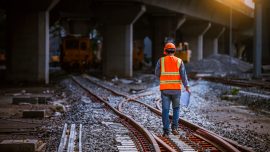
What is Railroad Ballast and How We Maintain It Under your Railroads
The old cliche that a building is only as strong as its foundation rings true both in a metaphorical and literal sense. When it comes to our railroads, one may initially think that the foundation is the tracks, ties, or sleepers, although that’s not quite true. The foundation of every railroad is the railroad ballast that holds everything in place, ensuring that it’s maintained properly will ensure the longevity of the railroad.
Here at RS Track, we employ a range of machinery to help maintain the ballast which keeps your railroads functioning. Using these pieces of machinery requires a certain type of professional such as a Midwest railroad contractor who is experienced with them. Keeping your ballast in check is an ongoing process, and understanding how each machine helps in doing so can save you both time and money in the long run.
What is Railroad Ballast?
As previously alluded to, the ballast is the foundation on which the railroad lies, and its quality has a huge impact on the efficacy and longevity of the rails. Unless you’re a Midwest railroad contractor, you may not be fully aware of the several purposes for the use of ballast under railroads:
— To bear the load from the railroad ties, as well as the train and cars
— Limiting the growth of vegetation that might interfere with the track
— To facilitate drainage of water so that the track isn’t affected during a heavy downpour
The ballast we use on our railroads typically consists of granite, quartzite, dolomite, limestone, and trap rock. These stones typically have hard and sharp edges which enable them to lock together under pressure, and the relatively loose nature allows for flexibility as loaded train cars move over them.
The importance of the ballast shouldn’t be lost on anyone, as it truly is the foundation of all railroads. We employ several tools to manage ballast.
Railroad Ballast Hopper Cars
These are a special kind of hopper car which allow the dumping of ballast on railroads during both construction and maintenance. They are bottom-dumping with hydraulically operated bottom gates that distribute it across the track section, and have bottom shoulder chutes to get the ballast past the tie ends.
Railroad Ballast Regulator
Once the ballast is dumped on the tracks, it needs to be distributed and shaped to ensure the roadbed is level for the rails. This is achieved using a self-propelled, rail-mounted machine known as a ballast regulator or ballast sweeper. Ballast regulators are employed during both construction and maintenance of railroads, and use three pieces of equipment to achieve their purpose:
The Plow Blades: Used to shape and move ballast, and typically consist of two blades that can be independently adjusted to various heights for either side of the track.
The Ballast Boxes: Used for two purposes, to bring ballast back to the centerline of the tracks, and contour it to slope downward away from the tracks perpendicularly.
The Rotating Brushes: After the plow blades and ballast boxes have moved and shaped the ballast appropriately, there will usually be some leftover covering the ties. The rotating brushes safely remove this ballast from the ties to allow for their visibility for a maintenance inspection.
While their main function is in managing ballast, it’s not uncommon for a Midwest railroad contractor to use these machines for plowing and moving snow, clearing bush from the tracks, laying cable, and digging ditches.
Tamping Machine
More typically employed for maintenance or repair, a tamping machine is a self-propelled, rail-mounted machine used to pack the ballast under the track to make them more durable and level. Once upon a time, this was done manually with tools called beaters, but the advent of this machine has saved both time and money, as well as being faster and more accurate.
In its basic form, a tamper only packs the ballast, but more modern innovations have included lining machines that can straighten out the rails benefitting both the comfort of the passenger and longevity of the rails themselves. The tamping machine is typically employed after the regulator and is usually the final process in setting or repairing the ballast under the railroads.
The Importance of an Experienced Midwest Railroad Contractor: R&S Track Maintenance, Inc.
The machinery used in managing ballast is highly effective, although no amount of machinery is going to help without the direction of an experienced professional. When it comes to inspecting the ballast under and around your ties, it can be important to get a second opinion from a local Midwest railroad contractor to confirm or deny any concerns.
Whether you’re planning on constructing, repairing, or simply maintaining the ballast under your railroads, be sure to contact us at RS Track to ensure you have a qualified Midwest railroad contractor at your side.




0 comments
Write a comment